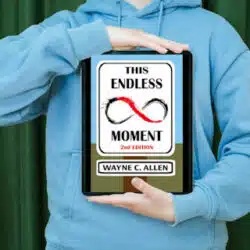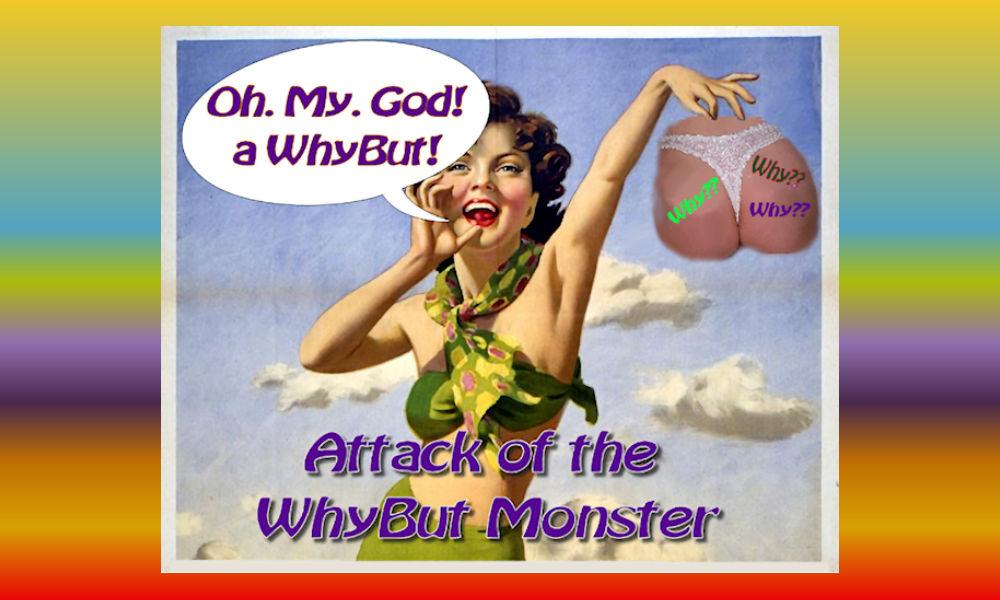- On Waking Up — Awake as Compared to Asleep
- On Waking Up — The Attack of the WhyBut Monster
- On Waking Up — Infinite Choice
Why and but are stop words. They are useful for getting us off-track, as we pretend to be working on our issues. Uttering either means that you are stuck, pure and simple.

An excellent guide to life and living.
Learn to focus your attention of who you really are.
Read This Endless Moment now!
So, here’s a recent question:
Hi Wayne I’d love you to write a post with a bit more detail on how we use ‘why’ to stay asleep. I do get the irony of asking you to explain why we ask why! I used to be very much a why girl until recently. I saw how much needing to know why stopped me from taking action. I finally realised we don’t have to know to move forward. From Jane
Let’s talk about our brain patterns. Brains use a ton more body energy than their weight — as compared to the rest of the body — so brains developed habits to use less energy.
A habit, a way of being, is an energy conservation device
The problem with habits (habitual patterns of thinking) is that, without effort, they are “invisible.” We might be spending 80% of our day going through the motions, and all of it is habit.
Which is why Zen is so adamant on “When washing dishes, wash dishes.” Such a focus frags us out of auto-pilot — we begin to be present — to pay attenton.
OK, so next step — thinking
Most humans think that thinking is really, really special. Now, sure, our ability to self-reflect separates us from most other animals, but we have to be careful here.
Constructive thought
This is what we were taught to do in school. How to think through a problem — say in math, or science — we know it as the scientific method. It involves starting where we are, applying rigorous criteria, and pushing ourselves to the next level.
Obsessive thought

Here’s where the WhyBut monster rears it’s ugly head(s).
Obsessive thought is re-hashing what we’re doing, complete with a large dose of self-criticism, in order to conserve energy — in other words, to stay stuck.
Seems counter-intuitive, but actual thinking is energy-intensive. Staying stuck while running a “whybut” tape is like putting a song on endless loop. Click. Done.
Staying stuck is easy. If you just stand there, knee deep, or deeper, in the muck, you are expending zero energy after the first “click.”
Getting out requires massive energy. Even taking one step — massive energy. Last article, I listed off thought patterns for both “why” and “but.”
but, but, but…
In reverse order, “but” has to do with thinking things through to the point where a next step is obvious, and then racing to the well of excuses.
- “But it’s not the right time.”
- “I know what to do, but I don’t have the energy.”
- “But I can’t act until I know the outcome.”
So, what’s the point?
Staying asleep, safely ensconced in the silken strands of our cocoon, is all about the safety or predictability.
We don’t act because we fear where we may end up. We fear catastrophic loss — and we fear that where we end up will be terrible.
And we judge ourselves for not acting, as our egos love the sensation of powerlessness and frustration.
Yet, the ego’s fear of change (and it’s use of mental scare tactics) is not based in fact. That said, the fear is “real.” Visceral. Until we get a hold of ourselves and give ourselves a shake.
It boils down to the simple truth that what we imagine and what is real is never the same.
Real is right in front of us, and imagination is filtered through our fears (or desires.)
“But,” you say, “you can’t be too prepared.” And I agree, so long as you are preparing, as opposed to fantasizing about preparing. Otherwise known as scaring yourself. Anything that gets in the way of doing is an issue.
Why-ning
I just coined that word, as that’s what it sounds like. The other illustration from last week is the “why” pattern. This one is less about making excuses than it is about delaying acting, preferably forever.

I had many clients who were expert why-ners. They could teach College level classes.
When pressed, they’ll come out with, “Until I know why, I can’t change things.” Which begs the tongue-in-cheek response, “Why not?”
Asking “why” has all the trappings of the scientific method. Except for the missing part — doing something. And we’re right back to the cocoon — safely wrapped up, going nowhere.
So, why is asleep so popular?
It’s everywhere. Consumerism is built upon it. Dis-satisfaction sells us products — we feel bad, we think we’re stuck… and an ad tells us we’ll be oh-so stimulated by a new car, be able to do anything with the the right tampon, that all our tomorrows will be perfect after a change in government.
Sadly, “it” never helps for long, because all we’re doing is shifting externals. How easy for the the advertiser: “Do the minimum to change something external to yourself, feel better for a bit, line our pockets, and we promise to suggest something new next week!”
We confuse acting randomly, or out of desire (“I’m sure that finding a new husband will do it for me… this time!”) with taking responsibility for acting in ways that match our sense of self.
Remember: asking why, or sitting on your buts, is what we’ve been taught to do. It passes for progress, for making an effort — we think, we assume we can live by figuring things out. And yet, without actually doing something, you’re stuck in your head, going around in circles.
The only way out is action.
A “but” friend lists off 10 things she could do differently, and then says, “… but I’m too tired to act!”
She knows! It’s right there. Do something different. Get off her butt, and her buts.
A “why” friend is feverishly running all over the world, looking for the right place, and Mr. Right. Spending money, taking courses, and thinking that if only she moves physically, somehow her inertia will be overcome, and “…things will start happening.”
She misses that her mental gymnastics are depriving her of actual experience. And moving (locational enlightenment) changes nothing — 6 weeks later, her baggage will arrive, and she’ll simply be stuck in a new location.
Running away, you see, is not the same as actually doing something. It’s sad. She too knows what she needs to do. And she stops herself with endless questions. Doubts, uncertainties.
Waking Up
Waking up requires unfolding action. Waking up is about seeing clearly what is “right here,” and choosing to immediately act in response, which flies in the face of our world’s monumental attraction to inertia.
“In the country of the blind, the one eyed-man is king” — Erasmus
Even a little action (like one eye) sets one apart from those who do not see — the asleep — those living on auto-pilot.
It does no good to try to explain any of this to those who choose auto-pilot. Waking up requires one thing — recognizing that there is no “right path,” no “right destination.” No, we are not here to fulfill our destiny, to accomplish some “fixed something.” We’re here to be alive.
To live
The more fully alive we are, the more we see and hear, and the more possibilities open up in front of us.
Most refuse to believe this, and refuse to experiment by living differently.
I once said to a friend, “Here you are, standing at the banquet of life, and all you ever eat is garbanzo beans.” (She tended, despite a myriad of opportunities, to sing the same, sad song, and refuse to change her actions.) Garbanzos, with a banquet surrounding her.
Living is savouring, tasting, experimenting, opening. And, when necessary, fighting.
In this pool of active living, what to do next is clear. You’ll know it, as clear as day.
Here’s what to resist: immediately asking “why,” trying to figure the rest of your life out, or “but-ing” yourself into submission.
It’s a hard sell, suggesting that the only thing we need to do is the next thing
There is no grand plan, and actions are always one-at-a-time.
Life’s like that — example: despite having my name on several books, I’ve never written a book. I’ve written words, sentences, chapters, over time, and all of that eventually coalesced into a book. It would never have evolved into a book without slow, steady action.
Or, it’s like this article. 1 hour in, I’m almost done. I had no idea, other than the WhyBut topic, where I was going, or where I’d end up. I wrote it anyway, word by word, moment by moment.
This is the key — to do what you choose to do, right now. If you are sitting there, stuck, do something. Get up, wiggle yourself, go interact with the world. Paint. Write. Walk. Run. Wash dishes.
And your life will come into being, as you enact it, moment by awake moment… Better than being eaten by the WhyBut monster.

